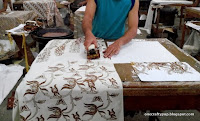Hello everyone,
Today I am going to discuss about Ikat. In other resist dyeing techniques in first woven and then is dyed but in Ikat the yarns are dyed first and then is weaved.
The fabric design is created in yarns rather than the cloth. In Ikat both the fabric faces are patterned. Ikat is charaterised with a blurry design. Well the bluriness can be reduced by using finer threads even by the skill of the craftman. It is mainly done in India, Central Asia, Southeast Asia, Japan, Africa and Latin America.
 Indonesian language word Ikat can be said to mean a cord, thread, knot or to bind or tie. There are mainly 4 types of Ikat:
Indonesian language word Ikat can be said to mean a cord, thread, knot or to bind or tie. There are mainly 4 types of Ikat:
 |
| Ikat |
The fabric design is created in yarns rather than the cloth. In Ikat both the fabric faces are patterned. Ikat is charaterised with a blurry design. Well the bluriness can be reduced by using finer threads even by the skill of the craftman. It is mainly done in India, Central Asia, Southeast Asia, Japan, Africa and Latin America.
 Indonesian language word Ikat can be said to mean a cord, thread, knot or to bind or tie. There are mainly 4 types of Ikat:
Indonesian language word Ikat can be said to mean a cord, thread, knot or to bind or tie. There are mainly 4 types of Ikat:- Warp Ikat
- Weft Ikat
- Double Ikat
- Oshima Ikat
Warp Ikat
In this method only the warp threads are dyed. Fabrics used: cotton, silk and wool. South American and Indonesian Ikat is known for its highly warp alignment.
 |
| Warp Ikat |
 |
| Warp Ikat |
Process
- Yarns are wound onto a frame.
- Then they are tied in the burdens ( can be covered with wax)
- Then the yarns are tied tightly with thread.
- Then the process is repeated to achieve the wanted colours
- Then the dyes yarns are send to the loom to get weaved.
Weft Ikat
It is more difficult to do. In this techniue the weft threads are dyed and then woven. Japanese weavers produce very accurate indigo and white weft Ikat with small scale motifs. Whereas, in Odisha, India have replicated fine urdu script in weft ikat.
 |
| Weft Ikat |
Double Ikat
In this technique both the weft and warp yarns are dyed. It is very difficult and hence expensive. It is mainly done in India and Indonesia. In this mainly done in India and Indonesia. Before the final weaving is done. Before the final weaving is done a manual winding is supposed to be done. It takes atleast 5 hrs per saree. In 1999, Malluham made a machine which does manual winding.
 |
| Double Ikat |
Oshima Ikat
In this type of Ikat both warp and weft ikat threads are used as warp to weave stiff fabric upon which the thread for Ikat is spot dyed. The Oshima ikat process is duplicated by Java and Bali, and is reserved for the ruling royalty.
 |
| Oshima Ikat |
References:
Ikat (2017) in Wikipedia. Available at:
https://en.wikipedia.org/wiki/Ikat (Accessed: 15 January 2017).
Hoffman,
A. (2012) The history of Ikat. Available at:
http://www.apartmenttherapy.com/warped-the-story-behind-ikat-r-105283
(Accessed: 16 January 2017).
Inc,
S. (2017) IKAT PPT.Pptx | weaving | textiles. Available at:
https://www.scribd.com/presentation/285871007/IKAT-PPT-pptx (Accessed: 16
January 2017).










































